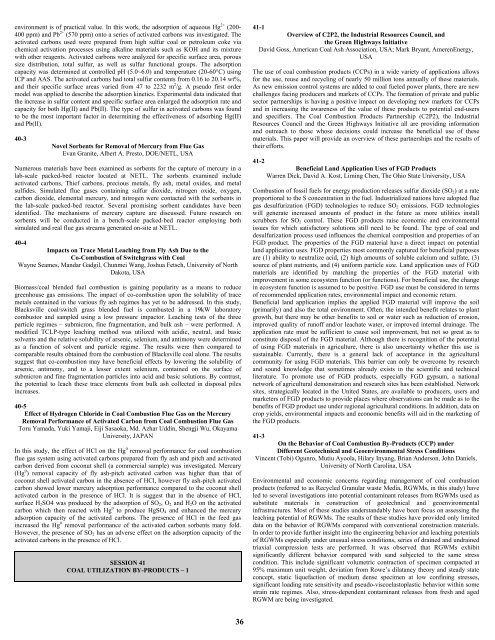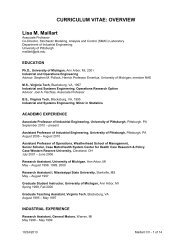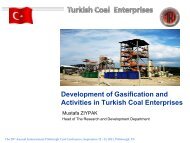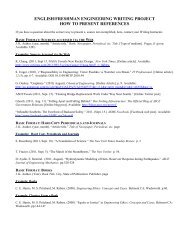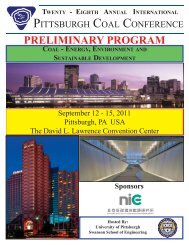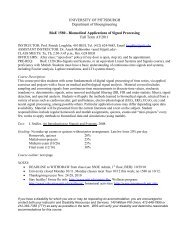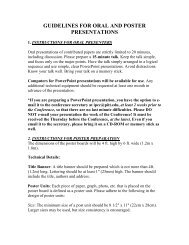Abstract Booklet 2006 - Swanson School of Engineering - University ...
Abstract Booklet 2006 - Swanson School of Engineering - University ...
Abstract Booklet 2006 - Swanson School of Engineering - University ...
You also want an ePaper? Increase the reach of your titles
YUMPU automatically turns print PDFs into web optimized ePapers that Google loves.
environment is <strong>of</strong> practical value. In this work, the adsorption <strong>of</strong> aqueous Hg 2+ (200-<br />
400 ppm) and Pb 2+ (570 ppm) onto a series <strong>of</strong> activated carbons was investigated. The<br />
activated carbons used were prepared from high sulfur coal or petroleum coke via<br />
chemical activation processes using alkaline materials such as KOH and its mixture<br />
with other reagents. Activated carbons were analyzed for specific surface area, porous<br />
size distribution, total sulfur, as well as sulfur functional groups. The adsorption<br />
capacity was determined at controlled pH (5.0~6.0) and temperature (20-60°C) using<br />
ICP and AAS. The activated carbons had total sulfur contents from 0.16 to 20.14 wt%,<br />
and their specific surface areas varied from 47 to 2232 m 2 /g. A pseudo first order<br />
model was applied to describe the adsorption kinetics. Experimental data indicated that<br />
the increase in sulfur content and specific surface area enlarged the adsorption rate and<br />
capacity for both Hg(II) and Pb(II). The type <strong>of</strong> sulfur in activated carbons was found<br />
to be the most important factor in determining the effectiveness <strong>of</strong> adsorbing Hg(II)<br />
and Pb(II).<br />
40-3<br />
Novel Sorbents for Removal <strong>of</strong> Mercury from Flue Gas<br />
Evan Granite, Albert A. Presto, DOE/NETL, USA<br />
Numerous materials have been examined as sorbents for the capture <strong>of</strong> mercury in a<br />
lab-scale packed-bed reactor located at NETL. The sorbents examined include<br />
activated carbons, Thief carbons, precious metals, fly ash, metal oxides, and metal<br />
sulfides. Simulated flue gases containing sulfur dioxide, nitrogen oxide, oxygen,<br />
carbon dioxide, elemental mercury, and nitrogen were contacted with the sorbents in<br />
the lab-scale packed-bed reactor. Several promising sorbent candidates have been<br />
identified. The mechanisms <strong>of</strong> mercury capture are discussed. Future research on<br />
sorbents will be conducted in a bench-scale packed-bed reactor employing both<br />
simulated and real flue gas streams generated on-site at NETL.<br />
40-4<br />
Impacts on Trace Metal Leaching from Fly Ash Due to the<br />
Co-Combustion <strong>of</strong> Switchgrass with Coal<br />
Wayne Seames, Mandar Gadgil, Chunmei Wang, Joshua Fetsch, <strong>University</strong> <strong>of</strong> North<br />
Dakota, USA<br />
Biomass/coal blended fuel combustion is gaining popularity as a means to reduce<br />
greenhouse gas emissions. The impact <strong>of</strong> co-combustion upon the solubility <strong>of</strong> trace<br />
metals contained in the various fly ash regimes has yet to be addressed. In this study,<br />
Blacksville coal/switch grass blended fuel is combusted in a 19kW laboratory<br />
combustor and sampled using a low pressure impactor. Leaching tests <strong>of</strong> the three<br />
particle regimes – submicron, fine fragmentation, and bulk ash – were performed. A<br />
modified TCLP-type leaching method was utilized with acidic, neutral, and basic<br />
solvents and the relative solubility <strong>of</strong> arsenic, selenium, and antimony were determined<br />
as a function <strong>of</strong> solvent and particle regime. The results were then compared to<br />
comparable results obtained from the combustion <strong>of</strong> Blacksville coal alone. The results<br />
suggest that co-combustion may have beneficial effects by lowering the solubility <strong>of</strong><br />
arsenic, antimony, and to a lesser extent selenium, contained on the surface <strong>of</strong><br />
submicron and fine fragmentation particles into acid and basic solutions. By contrast,<br />
the potential to leach these trace elements from bulk ash collected in disposal piles<br />
increases.<br />
40-5<br />
Effect <strong>of</strong> Hydrogen Chloride in Coal Combustion Flue Gas on the Mercury<br />
Removal Performance <strong>of</strong> Activated Carbon from Coal Combustion Flue Gas<br />
Toru Yamada, Yuki Yamaji, Eiji Sasaoka, Md. Azhar Uddin, Shengji Wu, Okayama<br />
<strong>University</strong>, JAPAN<br />
In this study, the effect <strong>of</strong> HCl on the Hg 0 removal performance for coal combustion<br />
flue gas system using activated carbons prepared from fly ash and pitch and activated<br />
carbon derived from coconut shell (a commercial sample) was investigated. Mercury<br />
(Hg 0 ) removal capacity <strong>of</strong> fly ash-pitch activated carbon was higher than that <strong>of</strong><br />
coconut shell activated carbon in the absence <strong>of</strong> HCl, however fly ash-pitch activated<br />
carbon showed lower mercury adsorption performance compared to the coconut shell<br />
activated carbon in the presence <strong>of</strong> HCl. It is suggest that in the absence <strong>of</strong> HCl,<br />
surface H 2 SO4 was produced by the adsorption <strong>of</strong> SO 2 , O 2 and H 2 O on the activated<br />
carbon which then reacted with Hg 0 to produce HgSO 4 and enhanced the mercury<br />
adsorption capacity <strong>of</strong> the activated carbons. The presence <strong>of</strong> HCl in the feed gas<br />
increased the Hg 0 removal performance <strong>of</strong> the activated carbon sorbents many fold.<br />
However, the presence <strong>of</strong> SO 2 has an adverse effect on the adsorption capacity <strong>of</strong> the<br />
activated carbons in the presence <strong>of</strong> HCl.<br />
SESSION 41<br />
COAL UTILIZATION BY-PRODUCTS – 1<br />
41-1<br />
Overview <strong>of</strong> C2P2, the Industrial Resources Council, and<br />
the Green Highways Initiative<br />
David Goss, American Coal Ash Association, USA; Mark Bryant, AmerenEnergy,<br />
USA<br />
The use <strong>of</strong> coal combustion products (CCPs) in a wide variety <strong>of</strong> applications allows<br />
for the use, reuse and recycling <strong>of</strong> nearly 50 million tons annually <strong>of</strong> these materials.<br />
As new emission control systems are added to coal fueled power plants, there are new<br />
challenges facing producers and markets <strong>of</strong> CCPs. The formation <strong>of</strong> private and public<br />
sector partnerships is having a positive impact on developing new markets for CCPs<br />
and in increasing the awareness <strong>of</strong> the value <strong>of</strong> these products to potential end-users<br />
and specifiers. The Coal Combustion Products Partnership (C2P2), the Industrial<br />
Resources Council and the Green Highways Initiative all are providing information<br />
and outreach to those whose decisions could increase the beneficial use <strong>of</strong> these<br />
materials. This paper will provide an overview <strong>of</strong> these partnerships and the results <strong>of</strong><br />
their efforts.<br />
41-2<br />
Beneficial Land Application Uses <strong>of</strong> FGD Products<br />
Warren Dick, David A. Kost, Liming Chen, The Ohio State <strong>University</strong>, USA<br />
Combustion <strong>of</strong> fossil fuels for energy production releases sulfur dioxide (SO 2 ) at a rate<br />
proportional to the S concentration in the fuel. Industrialized nations have adopted flue<br />
gas desulfurization (FGD) technologies to reduce SO 2 emissions. FGD technologies<br />
will generate increased amounts <strong>of</strong> product in the future as more utilities install<br />
scrubbers for SO 2 control. These FGD products raise economic and environmental<br />
issues for which satisfactory solutions still need to be found. The type <strong>of</strong> coal and<br />
desulfurization process used influences the chemical composition and properties <strong>of</strong> an<br />
FGD product. The properties <strong>of</strong> the FGD material have a direct impact on potential<br />
land application uses. FGD properties most commonly captured for beneficial purposes<br />
are (1) ability to neutralize acid, (2) high amounts <strong>of</strong> soluble calcium and sulfate, (3)<br />
source <strong>of</strong> plant nutrients, and (4) uniform particle size. Land application uses <strong>of</strong> FGD<br />
materials are identified by matching the properties <strong>of</strong> the FGD material with<br />
improvement in some ecosystem function (or functions). For beneficial use, the change<br />
in ecosystem function is assumed to be positive. FGD use must be considered in terms<br />
<strong>of</strong> recommended application rates, environmental impact and economic return.<br />
Beneficial land application implies the applied FGD material will improve the soil<br />
(primarily) and also the total environment. Often, the intended benefit relates to plant<br />
growth, but there may be other benefits to soil or water such as reduction <strong>of</strong> erosion,<br />
improved quality <strong>of</strong> run<strong>of</strong>f and/or leachate water, or improved internal drainage. The<br />
application rate must be sufficient to cause soil improvement, but not so great as to<br />
constitute disposal <strong>of</strong> the FGD material. Although there is recognition <strong>of</strong> the potential<br />
<strong>of</strong> using FGD materials in agriculture, there is also uncertainty whether this use is<br />
sustainable. Currently, there is a general lack <strong>of</strong> acceptance in the agricultural<br />
community for using FGD materials. This barrier can only be overcome by research<br />
and sound knowledge that sometimes already exists in the scientific and technical<br />
literature. To promote use <strong>of</strong> FGD products, especially FGD gypsum, a national<br />
network <strong>of</strong> agricultural demonstration and research sites has been established. Network<br />
sites, strategically located in the United States, are available to producers, users and<br />
marketers <strong>of</strong> FGD products to provide places where observations can be made as to the<br />
benefits <strong>of</strong> FGD product use under regional agricultural conditions. In addition, data on<br />
crop yields, environmental impacts and economic benefits will aid in the marketing <strong>of</strong><br />
the FGD products.<br />
41-3<br />
On the Behavior <strong>of</strong> Coal Combustion By-Products (CCP) under<br />
Different Geotechnical and Geoenvironmental Stress Conditions<br />
Vincent (Tobi) Ogunro, Mutiu Ayoola, Hilary Inyang, Brian Anderson, John Daniels,<br />
<strong>University</strong> <strong>of</strong> North Carolina, USA<br />
Environmental and economic concerns regarding management <strong>of</strong> coal combustion<br />
products (referred to as Recycled Granular waste Media, RGWMs, in this study) have<br />
led to several investigations into potential contaminant releases from RGWMs used as<br />
substitute materials in construction <strong>of</strong> geotechnical and geoenvironmental<br />
infrastructures. Most <strong>of</strong> these studies understandably have been focus on assessing the<br />
leaching potential <strong>of</strong> RGWMs. The results <strong>of</strong> these studies have provided only limited<br />
data on the behavior <strong>of</strong> RGWMs compared with conventional construction materials.<br />
In order to provide further insight into the engineering behavior and leaching potentials<br />
<strong>of</strong> RGWMs especially under unusual stress conditions, series <strong>of</strong> drained and undrained<br />
triaxial compression tests are performed. It was observed that RGWMs exhibit<br />
significantly different behavior compared with sand subjected to the same stress<br />
condition. This include significant volumetric contraction <strong>of</strong> specimen compacted at<br />
95% maximum unit weight, deviation from Rowe’s dilatancy theory and steady state<br />
concept, static liquefaction <strong>of</strong> medium dense specimen at low confining stresses,<br />
significant loading rate sensitivity and pseudo-viscoelastoplastic behavior within some<br />
strain rate regimes. Also, stress-dependent contaminant releases from fresh and aged<br />
RGWM are being investigated.<br />
36


